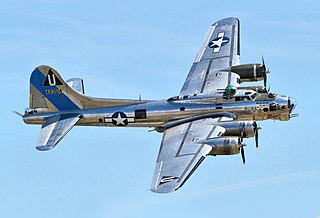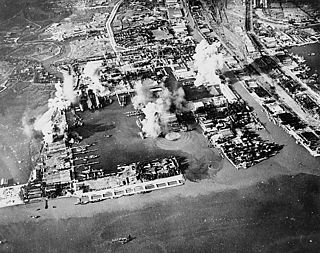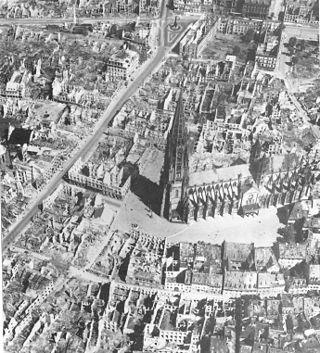
The Boeing B-17 Flying Fortress is a four-engined heavy bomber developed in the 1930s for the United States Army Air Corps (USAAC). Relatively fast and high-flying for a bomber of its era, the B-17 was used primarily in the European Theater of Operations and dropped more bombs than any other aircraft during World War II. It is the third-most produced bomber of all time, behind the four-engined Consolidated B-24 Liberator and the multirole, twin-engined Junkers Ju 88. It was also employed as a transport, antisubmarine aircraft, drone controller, and search-and-rescue aircraft.

The bombing of Dresden was a joint British and American aerial bombing attack on the city of Dresden, the capital of the German state of Saxony, during World War II. In four raids between 13 and 15 February 1945, 772 heavy bombers of the Royal Air Force (RAF) and 527 of the United States Army Air Forces (USAAF) dropped more than 3,900 tons of high-explosive bombs and incendiary devices on the city. The bombing and the resulting firestorm destroyed more than 1,600 acres (6.5 km2) of the city centre. An estimated 22,700 to 35,000 people were killed. Three more USAAF air raids followed, two occurring on 2 March aimed at the city's railway marshalling yard and one smaller raid on 17 April aimed at industrial areas.

The Bombing of Tokyo was a series of firebombing air raids by the United States Army Air Force during the Pacific campaigns of World War II. Operation Meetinghouse, which was conducted on the night of 9–10 March 1945, is the single most destructive bombing raid in human history. 16 square miles of central Tokyo were destroyed, leaving an estimated 100,000 civilians dead and over one million homeless. In comparison, the atomic bombing of Hiroshima in August 1945 resulted in the immediate death of between 70,000 and 150,000 people.

The 1st Airborne Division was an airborne infantry division of the British Army during the Second World War. The division was formed in late 1941 during the Second World War, after the British Prime Minister, Winston Churchill, demanded an airborne force, and was initially under command of Major-General Frederick A. M. "Boy" Browning. The division was one of two airborne divisions raised by the British Army during the war, with the other being the 6th Airborne Division, created in May 1943, using former units of the 1st Airborne Division.

The second Schweinfurt raid, also called Black Thursday, was a World War II air battle that took place on 14 October 1943, over Nazi Germany between forces of the United States 8th Air Force and German Luftwaffe fighter arm (Jagdwaffe). The American bombers conducted a strategic bombing raid on ball bearing factories to reduce production of these vital parts for all manner of war machines. This was the second attack on the factories at Schweinfurt. American wartime intelligence claimed the first Schweinfurt–Regensburg mission in August had reduced bearing production by 34 percent but had cost many bombers. A planned follow-up raid had to be postponed to rebuild American forces.
The Commonwealth of the Philippines was attacked by the Empire of Japan on 8 December 1941, nine hours after the attack on Pearl Harbor. Although it was governed by a semi-independent commonwealth government, the United States of America controlled the Philippines at the time and possessed important military bases there. The combined Filipino-American army was defeated in the Battle of Bataan, which saw many war crimes commited and the Battle of Corregidor in April 1942, but guerrilla resistance against the Japanese continued throughout the war. Uncaptured Filipino army units, a communist insurgency, and supporting American agents all played a role in the resistance. Due to the huge number of islands, the Japanese never occupied many of the smaller and more minor islands. The Japanese control over the countryside and smaller towns were often tenuous at best.

Operation Cockpit was an Allied attack against the Japanese-held island of Sabang on 19 April 1944. It was conducted by aircraft flying from British and American aircraft carriers and targeted Japanese shipping and airfields. A small number of Japanese ships and aircraft were destroyed, and one American aircraft was lost. While the attack was successful tactically, it failed to divert Japanese forces from other areas as had been hoped.

Darmstadt was bombed a number of times during World War II. The most devastating air raid on Darmstadt occurred on the night of 11/12 September 1944 when No. 5 Group of the Royal Air Force (RAF) bombed the city. 66,000 of the 110,000 inhabitants of Darmstadt at the time became homeless. Darmstadt lost between 12,500 and 13,500 inhabitants during World War II. The calligraphic memorial Darmstädter Brandnamen lists about 4,000 names. Darmstadt had several major industrial targets including Merck and Rohm and Haas chemical works as well as military communications networks.

Royal Air Force Thorpe Abbotts or more simply RAF Thorpe Abbotts is a former Royal Air Force station located 4 miles (6.4 km) east of Diss, Norfolk, England.

Operation Transom was an attack by Allied forces against the Japanese-occupied city of Surabaya on the Indonesian island of Java during World War II. Conducted by the British-led Eastern Fleet, the operation took place on 17 May 1944 and involved American and British carrier-based aircraft bombing the city's docks and an oil refinery. An American torpedo bomber was shot down, and two British torpedo bombers were lost in accidents.

On 6 and 9 August 1945, the United States detonated two atomic bombs over the Japanese cities of Hiroshima and Nagasaki, respectively. The aerial bombings together killed between 129,000 and 226,000 people, most of whom were civilians, and remain the only use of nuclear weapons in an armed conflict. Japan surrendered to the Allies on 15 August, six days after the bombing of Nagasaki and the Soviet Union's declaration of war against Japan and invasion of Japanese-occupied Manchuria. The Japanese government signed the instrument of surrender on 2 September, effectively ending the war.

The Bombing of Hamamatsu in World War II was part of the strategic bombing campaign waged by the United States of America against military and civilian targets and population centers of the Empire of Japan during the Japan home islands campaign in the closing states of World War II.

The Bombing of Numazu in World War II was part of the strategic bombing campaign waged by the United States against military and civilian targets and population centers during the Japan home islands campaign in the closing stages of World War II.

The Bombing of Shizuoka in World War II on June 19, 1945, was part of the strategic bombing campaign waged by the United States against military and civilian targets and population centers during the Japan home islands campaign in the closing stages of World War II.

The Bombing of Tokokawa in World War II was part of the strategic bombing campaign waged by the United States of America against military and civilian targets and population centers during the Japan home islands campaign in the closing stages of World War II.

The Bombing of Kōfu in World War II was part of the strategic bombing campaign waged by the United States against military and civilian targets and population centers of the Empire of Japan during the Japan home islands campaign in the closing states of World War II.

Operation Tigerfish was the military code name in World War II for the air raid on Freiburg in the evening of 27 November 1944 by the Royal Air Force with about 2,800 dead.

The bombing of Nagaoka took place on the night of 1 August 1945, as part of the strategic bombing campaign waged by the United States against military and civilian targets and population centers in the Japan home islands during the closing stages of World War II. Between 65.5 and 80 percent of the urban area of Nagaoka was destroyed during the bombing.

The aerial bombings of Hanover are a series of eighty-eight air raids by Royal Air Force (RAF) Bomber Command and the United States Army Air Forces (USAAF) on the German city of Hanover during World War II. Collectively these air raids killed 6,782 persons, predominantly civilian residents. Around 1,000 aerial mines, 34,000 high explosive bombs, 900,000 incendiary bombs and 50,000 fire bombs were dropped. The most destructive and deadly air raid on Hanover was conducted by the RAF on the night beginning 8 October 1943, killing 1,245 persons, and is an example of carpet bombing of suburban and residential civilian targets laid out in the Area Bombing Directive of 14 February 1942.

















